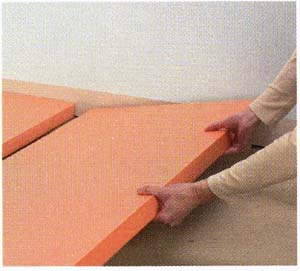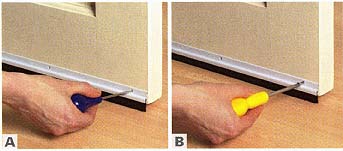Insulating floors can greatly help reduce heat loss, and can help with soundproofing. To reduce heat loss, you may want to insulate floors over unheated basements or other unheated or open spaces, such as garages and porches. For sound absorption help, insulation can affect any room that has mostly hard surfaces. If you are working with an open floor of exposed joists, always walk on the joists or lay plywood for safe working areas. Kraft- and foil-faced insulation will burn, so never leave faced insulation exposed. These products must be installed in substantial contact with an approved construction material to help prevent the spread of fire.
You can insulate both concrete and wooden floors using insulation boards. The stage at which they are laid will depend on floor age and type. Vapor barriers are used in older properties, and help to prevent ground moisture from getting into a wood floor.  above: Laying a floating floor: On sound concrete you can lay insulation boards directly on the concrete surface.  above: Using furring strips : Where you have furring strips at intervals across a floor, you can slot insulation panels between them.  above: Before laying concrete : Where concrete is still to be laid, lay the insulation panels first and then lay the concrete on top. |
Installing Insulation Around Rafters
Starting at the perimeter of the attic, measure and cut the insulation to length. Place the insulation with the vapor barrier down. If you live in a humid climate, or are placing insulation over another layer of insulation, place the insulation with the vapor barrier facing upward.
A. Insert the insulation below any cables when laying insulation through joist bays.
B. Score the top of the insulation along the cable with a utility knife.
C. Peel the top half over the cable to cover it.Installing Seals
Sealing doors is an easy trick for reducing energy loss in your home. Requiring minimum tools and materials, a door seal runs along the bottom of your door to cover any gaps. Especially popular in older homes, a door sweep (shown here) requires screws to stay in place. Thresholds are another popular option to reduce air flow under the door. Gaskets, self-adhesive silicone, and foam are options to seal the tops of doors.
A. Position the seal so that its bristles just touch and bend on the floor. Use an awl to mark where fasteners are needed.
B. Screw the seal to the door. Move the door back and forth to check that the seal is positioned correctly, before securing the final screws.
Sealing Front Doors
Front doors can be a major source of drafts, especially if your home does not have a porch. Ensure that in addition to sealing gaps around the edges of the door, you seal any openings or gaps and caulk any cracks in the trim.
Safety
Safety is important when working with insulation materials.
- Always wear a mask, gloves, and safety glasses.
- Avoid direct contact with skin because insulation can cause irritation.
- Never install insulation near flames, electrical equipment, or heating equipment.
Always build a barrier around any light fixtures to keep insulation at least 3 in (70 mm) away (see this page for more info).
Next: Soundproofing a Room

